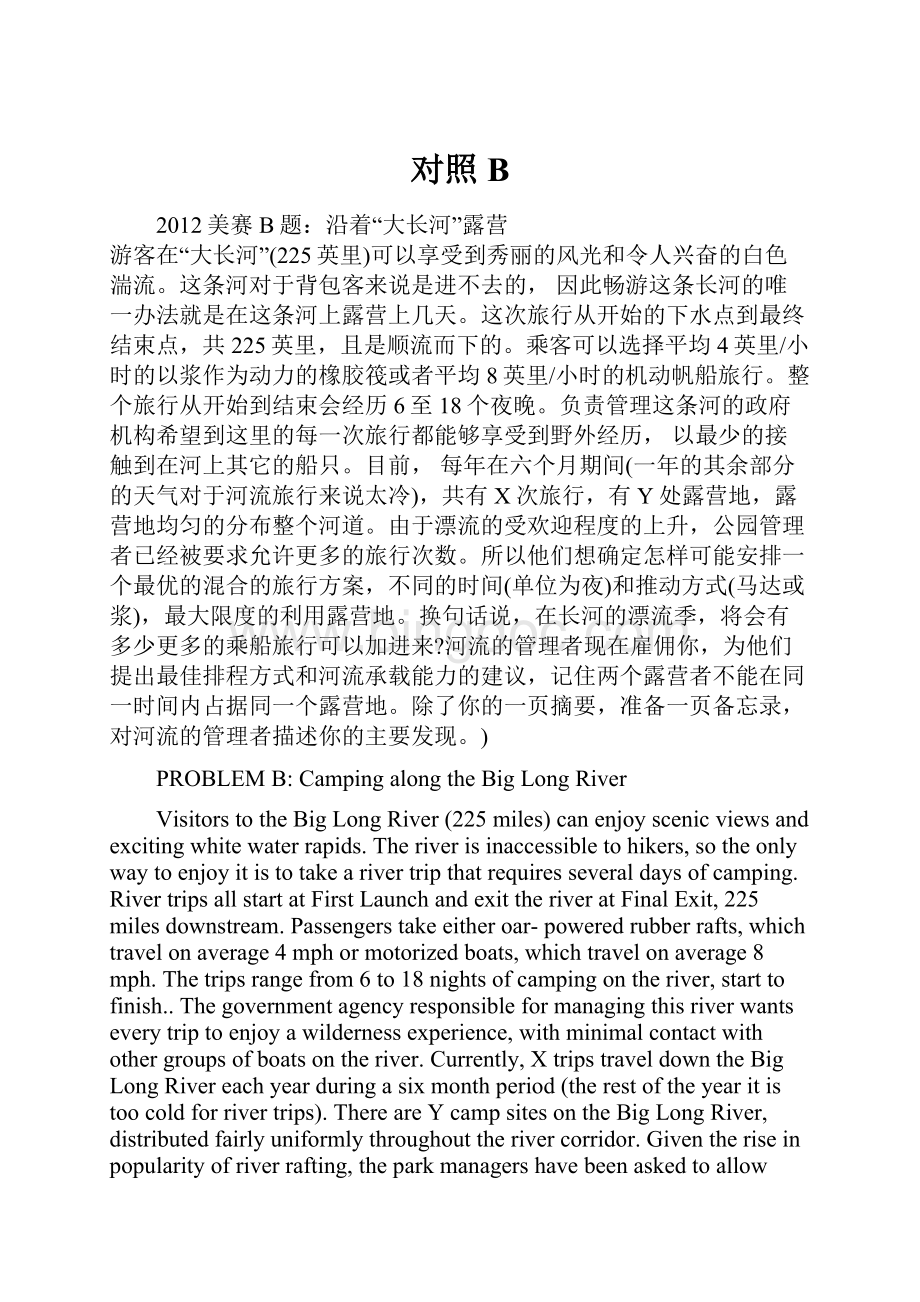对照BWord格式.docx
《对照BWord格式.docx》由会员分享,可在线阅读,更多相关《对照BWord格式.docx(28页珍藏版)》请在冰点文库上搜索。

伯恩
特拉维斯·
彼得斯
WesternWashington大学
贝灵汉佤邦
顾问:
AmiranEdohy
文摘
我们开发了一个模型来安排行程沿着大长河。
目的
是最佳计划乘船旅行的持续时间和不同的推进,吗
最大化的次数超过6个月的赛季。
我们的模型组旅行的过程从营地露营地。
受给定的约束,我们的算法输出最佳日报
每组安排在河上。
通过研究算法的长期
行为,我们可以计算一个最大数量的旅行,我们定义为
河流的承载能力。
我们运用我们的算法来一个案例研究的大峡谷,
许多共同的属性,与大长河。
最后,我们检查承载能力的变化的敏感度
分布的推进方法、分布的旅行时间,
数量的营地在河上。
ComputingAlongtheBigLongRiver
ChipJackson
LucasBourne
TravisPeters
WesternWashingtonUniversity
Bellingham,WA
Advisor:
EdohY.Amiran
Abstract
WedevelopamodeltoscheduletripsdowntheBigLongRiver.Thegoal
istooptimallyplanboattripsofvaryingdurationandpropulsionsoasto
maximizethenumberoftripsoverthesix-monthseason.
Wemodeltheprocessbywhichgroupstravelfromcampsitetocampsite.
Subjecttothegivenconstraints,ouralgorithmoutputstheoptimaldaily
scheduleforeachgroupontheriver.Bystudyingthealgorithm’slong-term
behavior,wecancomputeamaximumnumberoftrips,whichwedefineas
theriver’scarryingcapacity.
WeapplyouralgorithmtoacasestudyoftheGrandCanyon,whichhas
manyattributesincommonwiththeBigLongRiver.
Finally,weexaminethecarryingcapacity’ssensitivitytochangesinthe
distributionofpropulsionmethods,distributionoftripduration,andthe
numberofcampsitesontheriver.
介绍
我们的地址调度休闲旅行了大长河等
为了最大化的次数。
从第一次发射到最终退出(225米)。
参与者都接受一个或者橡胶筏或电动船。
旅行持续6到18岁之间的夜晚,在指定参与者露营
沿着河边露营。
确保一个真正的荒野的经验,
在一次最多的一组可能占领一个营地。
这个约束限制
可能的旅行的数量在公园的六个月的赛季。
我们的模型情况,然后比较我们的结果,以反映河流
类似的属性,从而验证我们的方法产生理想的结果。
我们的模型很容易适应找到最佳的旅行日程河流
不同的长度、数量的营地,旅行持续时间和船的速度。
定义问题
•应该怎样旅行的不同长度和推进预定
最大化的次数可能在一个六个月的赛季?
有多少新的群体可以•开始一次漂流在任何给定的一天?
•什么是承载能力的——的最大数量
组,可以发送顺流而下在其六个月的赛季?
Introduction
WeaddressschedulingrecreationaltripsdowntheBigLongRiversoas
tomaximizethenumberoftrips.FromFirstLaunchtoFinalExit(225mi),
participantstakeeitheranoar-poweredrubberraftoramotorizedboat.
Tripslastbetween6and18nights,withparticipantscampingatdesignated
campsitesalongtheriver.Toensureanauthenticwildernessexperience,
atmostonegroupatatimemayoccupyacampsite.Thisconstraintlimits
thenumberofpossibletripsduringthepark’ssix-monthseason.
Wemodelthesituationandthencompareourresultstoriverswith
similarattributes,thusverifyingthatourapproachyieldsdesirableresults.
Ourmodeliseasilyadaptabletofindoptimaltripschedulesforrivers
ofvaryinglength,numbersofcampsites,tripdurations,andboatspeeds.
DefiningtheProblem
•Howshouldtripsofvaryinglengthandpropulsionbescheduledto
maximizethenumberoftripspossibleoverasix-monthseason?
•Howmanynewgroupscanstartarivertriponanygivenday?
•Whatisthecarryingcapacityoftheriver—themaximumnumberof
groupsthatcanbesentdowntheriverduringitssix-monthseason?
模型概述
我们设计一个模型,该模型
可以应用到现实世界•河流与类似的属性(即。
大
峡谷);
•足够灵活,能够模拟各种可行的输入;
•以函数分布,模拟河旅行调度,得知的旅行
长度(无论是6、12、或18天),一个不同分布的推进
速度,以及不同数量的营地。
该模型预测的次数超过一个六个月的赛季。
它还
解决了河的承载量,有优势的
前进速度和旅行的长度,多少组可以
开始每天一次漂流,怎么安排行程。
约束
这个问题指定以下限制:
•在首次发射旅行开始和结束在最后退出,下游225英里。
•只有两种类型的船:
或者橡胶皮筏和机动
船。
•或者橡胶木筏4英里每小时平均旅行。
•机帆船旅行平均8英里/时。
•组旅行的范围从6到18夜。
旅行预定在•今年六个月的时间。
•营地沿着河分布均匀。
没有两个团体可以占据•相同的露营地在同一时间。
ModelOverview
Wedesignamodelthat
•canbeappliedtoreal-worldriverswithsimilarattributes(i.e.,theGrand
Canyon);
•isflexibleenoughtosimulateawiderangeoffeasibleinputs;
and
•simulatesriver-tripschedulingasafunctionofadistributionoftrip
lengths(either6,12,or18days),avaryingdistributionofpropulsion
speeds,andavaryingnumberofcampsites.
Themodelpredictsthenumberoftripsoverasix-monthseason.Italso
answersquestionsaboutthecarryingcapacityoftheriver,advantageous
distributionsofpropulsionspeedsandtriplengths,howmanygroupscan
startarivertripeachday,andhowtoscheduletrips.
Constraints
Theproblemspecifiesthefollowingconstraints:
•TripsbeginatFirstLaunchandendatFinalExit,225milesdownstream.
•Thereareonlytwotypesofboats:
oar-poweredrubberraftsandmotorized
boats.
•Oar-poweredrubberraftstravel4mphonaverage.
•Motorizedboatstravel8mphonaverage.
•Grouptripsrangefrom6to18nights.
•Tripsarescheduledduringasix-monthperiodoftheyear.
•Campsitesaredistributeduniformlyalongtheriver.
•Notwogroupscanoccupythesamecampsiteatthesametime.
假设
我们可以开比•艇来的河流或者机帆船(规定每天开到河上的橡胶筏和
走在这条河上的每一天。
机动帆船的比率)
可以有问题或者如果太多渔船推出
短途旅行的长度。
•旅行的时间要么是12天或18天或者筏、
和要么6天或12天机动船只。
这种简化仍然允许我们的模型产生有意义的结果
而让我们比较一下出行长度不同的影响。
•只能有一组每夜每营地。
这同意的欲望河经理。
•每一天,一群只能往下游或保持在当前
营地它不能搬回上游。
这个限制流动的组织一个方向,大大简化
我们如何可以将组织从营地露营地。
•组可以旅行只有从早上8点到下午6点。
(10小时),一个最大的9
每天数小时的旅行(一个小时是扣减免/午餐/等等)。
这意味着每天最多可以旅行或者木筏36英里,
和电动船最多72英里。
这种假设允许我们
确定哪些团体可以合理地达到给定的营地。
•团队从来没有比距离更远,他们能够真正地旅行
在一天:
36英里每一天和72英里/或者木筏
天机动船只。
Assumptions
•Wecanprescribetheratioofoar-poweredriverraftstomotorizedboats
thatgoontotherivereachday.
Therecanbeproblemsiftoomanyoar-poweredboatsarelaunchedwith
shorttriplengths.
•Thedurationofatripiseither12daysor18daysforoar-poweredrafts,
andeither6daysor12daysformotorizedboats.
Thissimplificationstillallowsourmodeltoproducemeaningfulresults
whilelettinguscomparetheeffectofvaryingtriplengths.
•Therecanonlybeonegrouppercampsitepernight.
Thisagreeswiththedesiresoftherivermanager.
•Eachday,agroupcanonlymovedownstreamorremaininitscurrent
campsite—itcannotmovebackupstream.
Thisrestrictstheflowofgroupstoasingledirection,greatlysimplifying
howwecanmovegroupsfromcampsitetocampsite.
•Groupscantravelonlybetween8a.m.and6p.m.,amaximumof9
hoursoftravelperday(onehourissubtractedforbreaks/lunch/etc.).
Thisimpliesthatperday,oar-poweredraftscantravelatmost36miles,
andmotorizedboatsatmost72miles.Thisassumptionallowsusto
determinewhichgroupscanreasonablyreachagivencampsite.
•Groupsnevertravelfartherthanthedistancethattheycanfeasiblytravel
inasingleday:
36milesperdayforoar-poweredraftsand72milesper
dayformotorizedboats.
我们忽略了变量可能•影响最大日常出行距离,
比如天气和河条件。
没有办法准确地包括了这些模型。
•营地分布均匀,营地之间的距离
是河流的长度除以营地的数量。
我们可以因此代表河流作为数组的条平行的营地。
(等间距的)
•一组必须达到河的结束最后一天的旅行:
——一个集团不会离开河早期即使能够。
——一个集团将没有完成日期过去所需的旅行距离。
这种假设适合我们相信是一个重要的标准
河经理和品质保证的旅行。
表1。
符号。
象征意义
Gi组我第i组
Ti旅行长度为集团我,以夜;
6≤ti≤18第i组一共几夜
Di数量的夜集团我花了河上的第i组在河上己过几夜
Y数量的营地在河上河上总营地数
cY位置的营地Y在英里下游;
0<
cY<
225第y个营地的位置
c0营地代表首次发射(用来构造一个候补名单的团体)第一个营地(起点)
cfinal营地(这始终是“开放”)代表最终退出最后一个营地(终点)
li位置我当前的露营地组英里顺流而下,0<
李<
225组i的位置
ai平均距离,集团我应该搬每天准时;
ai=225/钛i组每天移动距离
mi最大距离集团我可以在一天内旅行i组一天移动最大距离
Pi优先组我;
Pi=(di/ti)(李/225)i组的优先级
Gc(集合)套组,可以到达营地c可到达营地C的组的集合
R比率的木筏,或者每天机帆船推出橡皮/动力
X当前数量的旅行下来每年大长河每年组数
M高峰的承载能力河(最大数量的组最大组数
这可以发送顺流而下在其六个月的赛季)
D分布的旅行时间的团体在河上组安排的时间分布
方法
我们定义一些术语和短语:
开放的营地:
Acampsite是开放的,如果没有groupcurrently占领
它:
营地开放如果没有组cngi是分配给cn。
搬到一个开放的营地:
一组胃肠道,其营地cn,搬到
其他一些开放的营地cm=cn相当于gi的分配
新营地。
因为一个组可以只移动下游,或留在
他们当前的露营地,我们必须有m≥n。
候补名单:
对于一个给定的天的候补名单由分组,而不是
然而在河上但将开始他们的旅行的那天他们的排名
在候补名单和他们的能力来达到一个营地c把他们包含到
设置Gc的团体可以到达营地c,该组织被认为
“最高的优先级。
“候选组是初始化一个电流
营地的价值c0(第0个营地),和被假定为是
优先级P=1,直到他们被移动到河的候补名单。
从河:
我们认为第一个空间从河是“最后
“cfinal营地,它总是一个开放的营地(这样任意数量的
组织可以分配给它。
这是一致的理解
任何数量的组可以离开河流的一天。
Methods
Wedefinesometermsandphrases:
Opencampsite:
Acampsiteisopenifthereisnogroupcurrentlyoccupying
it:
Campsitecnisopenifnogroupgiisassignedtocn.
Movingtoanopencamps